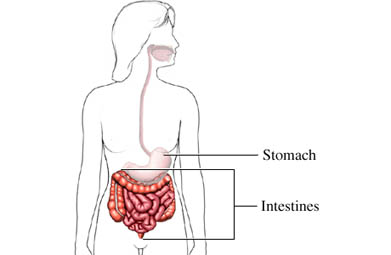Definition
Enteroclysis is a visual exam of the small intestine. The exam is done using a technique called fluoroscopy. This involves using an x-ray unit with a camera and a screen.
| The Intestines |

|
| Copyright © 2002 Nucleus Communications, Inc. All rights reserved. |
Reasons for Procedure
Enteroclysis is used to examine and diagnose conditions that affect the small intestine, such as:
- Obstruction in the small intestine
- Inflammatory bowel disease, such as Crohn disease
- Gastrointestinal bleeding
- Malabsorption
- Polyps
- Tumors
- Changes that have happened due to surgery such as scar tissue
Possible Complications
Problems from the procedure are rare. However, all procedures have some risk. Your doctor will review potential problems, like:
- Allergic reaction to the contrast dye—a chemical used to make images clearer
- Injury to the small intestines
- Bleeding
Factors that may increase the risk of complications include:
- Smoking
- Treatment with certain medicines such as aspirin or other blood-thinning medicines
Talk to your doctor about these risks before the procedure.
What to Expect
Prior to Procedure
Your doctor may:
- Do a physical exam
- Ask about your medical history, symptoms, and any medicines that you take
- Ask you to stop taking certain medicines before the test
To prepare for the procedure, your doctor may ask you to:
- Follow a clear-liquid diet (such as, water, tea, clear broth) the day before the enteroclysis.
- Take a laxative the night before.
- Avoid eating or drinking anything after midnight.
-
Give yourself an enema to clear stool from the intestines.
- Note: Be sure to tell your doctor if you are constipated. It’s important that your intestines are clear of stool.
On the day of the procedure:
- Wear comfortable clothing.
- Arrange for a ride home.
Anesthesia
Your doctor may give you a sedative to reduce your discomfort.
Description of the Procedure
You will be asked to lie down on an x-ray table. A numbing medicine will be sprayed on the back of your throat. A thin, flexible tube will then be placed into your mouth. The tube will be gently passed down your throat. The tip of the tube will pass through your stomach to your small intestines.
A special dye will be sent through the tube. You may be asked to move your body. This will help coat the walls of your intestine with the dye. The images of your intestine will then be taken.
A tube may also be placed in your rectum. The tube will allow some of the contrast dye to come out of your body. This step can reduce bloating in your abdomen.
After your doctor has taken all of the images, the tubes will be removed.
How Long Will It Take?
About 60 minutes
Will It Hurt?
You will have discomfort when the tube is inserted. You may also have some bloating and discomfort due to the contrast dye.
Post-procedure Care
Right after the procedure, the staff will bring you to the rest room. You will remain at the care center for about 30 minutes. Then you will be able to go home. If you were given a sedative, you will need someone to drive you home.
When you return home, resume medicines as instructed by your doctor.
Call Your Doctor
Call your doctor if any of these occur:
- Signs of infection, including fever and chills
- Severe abdominal pain
- Inability to pass gas or stool
If you think you have an emergency, call for emergency medical services right away.
RESOURCES
American Society for Gastrointestinal Endoscopy https://www.asge.org
National Institute of Diabetes and Digestive and Kidney Diseases https://www.niddk.nih.gov
CANADIAN RESOURCES
Canadian Association of Gastroenterology https://www.cag-acg.org
Public Health Agency of Canada https://www.canada.ca
References
Enteroclysis. Lahey Clinic website. Available at: https://www.lahey.org/Departments%5Fand%5FLocations/Departments/Radiology/Fluoroscopy/Enteroclysis.aspx. Accessed October 3, 2017.
Enteroclysis. Radiopaedia website. Available at: https://radiopaedia.org/articles/enteroclysis. Accessed October 3, 2017.
Revision Information
- Reviewer: EBSCO Medical Review Board Daus Mahnke, MD
- Review Date: 09/2018
- Update Date: 09/16/2020
